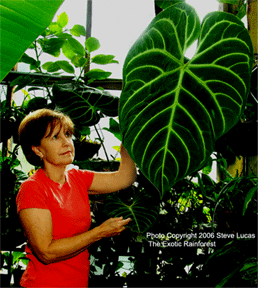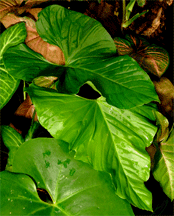![]()
Aroids and other genera in the Collection
Take the Tour Now?
Orchids
The
Exotic Rainforest
Join the club! But it can be found!
 Determining
the exact species name of many plants, especially aroids (Philodendron,
Anthurium, Alocasia, and others) can be challenging. Although
common, most people simply refuse to accept the concept of "variation"
within a species. They expect every single leaf of every species
to look alike. And in aroids, and many other species, that just
does not happen. Plants are variable and this link will help you
to understand that scientific concept:
Click here.
Determining
the exact species name of many plants, especially aroids (Philodendron,
Anthurium, Alocasia, and others) can be challenging. Although
common, most people simply refuse to accept the concept of "variation"
within a species. They expect every single leaf of every species
to look alike. And in aroids, and many other species, that just
does not happen. Plants are variable and this link will help you
to understand that scientific concept:
Click here.
Here's a simply way to understand. How many people do you know? Write down a number. How many of those people look exactly alike? Write down that number. What species are all those people? I'd bet you're writing down Homo sapiens. Are all of your friends the exact same height? Do they all weigh the same weight? Are all the same race? Do they all have the same hair color? Are all of them skinny? Overweight? The answer in almost every case is obviously to the negative. Humans are "variable". Plant species are the same way. Within any given species there can be a great deal of variation. That plant species may look "generally" like other plants of its species, but not all the leaves are identical. Some aren't even close! And yes, even Anthurium regale shown here can be variable.
And to complicate the situation, aroids love to morph as they grow. They literally change their shape as they grow from juvenile to adult forms. Many have multiple growth forms (Philodendron radiatum and Philodendron hederaceum which you likely know as Philodendron scandens, Philodendron micans or one of a large group of names are simply variations! As a result, they look like very different plants, but they are still the same species, and thousands of plant species are variable! You'll find discussions all throughout this website about "morphing" and "variation".
Chances are
most of the plants in your collection are still juveniles. They
don't look like their adult forms. As a result, determining the
exact species you are growing is often difficult. Many juvenile
forms of different species look exactly alike! Those of us who are
serious plant collectors often change the tags on our plants once they
mature and we learn we have something different than what we originally
expected, and botanists have the same problem. Within the
rain forest you can find numerous plants that look very different, but
are actually the same species. And you can find many juveniles
that look exactly alike but are truly different species. Some
plants, such as Philodendron hederaceum have possibly as many as
1000 forms. As a result, that plant has a large number of
botanical names. Especially in the early days of
botany, botanical scientists did not understand variability and that
arguement dates back close to 200 years! So
when they encountered a "new" plant, they would give it a "new" name.
Today, those names are called synonyms.
People send me photos of plants all the time asking for an
identification. If I don't recognize it, I'll send the photo on to
a number of experts including the world's most noted aroid botanist, Dr.
Tom Croat, of the Missouri Botanical Garden as well as several others.
And quite often, once I provide the determination back to the person who
asked, they tell me "you're experts are wrong". In that case, I
often wonder why they even bothered to ask. Especially if the
person has already made up their own mind and is simply looking for
someone to echo their opinion. And to many of those people, the
word variablity simply cannot be understood.
I recently asked noted aroid expert Julius Boos to help explain how a
botanist determines what species he is actually working with. As
you will read, Julius has a unique writing style. But he knows his
stuff! In this case, he used the genus Monstera since that
was the genus we were discussing at the moment and is one of the more
difficult to accurately determine. Here is what Julius had to say:
Please allow me a moment to attempt to explain how a taxonomist may I.D. any specimen sent to him.
In MOST cases, the expert will need to see the plant specimen, or better yet a series of specimens, (or in rare cases a series of GOOD photos which MUST show an ADULT plant and infloresence, and should show close-ups of the spadix at male anthesis). The specimens/photos should be of a mature plant, and have several leaves in which the examiner can look closely at both sides of the leaf blade, and the petiole, rhizome, etc. The specimens MUST have good collecting data attached. In other words, we need to know exactly where the specimen was collected.
The genus/species in which you are interested ( Monstera) are almost impossible to I.D. to species without GOOD collecting data. In the case of Monstera, unless you can supply COLLECTION DATA and a series of better photos, it may be impossible to ID your specimen even WITH an infloresence. This genus occurs widely, from Mexico, through Central America and the West Indies and down throughout South America to Southern Brazil, over 40 species, so without critical collection data it is impossible for even the expert on the genus Monstera, who just happens to be Dr. Tom Croat, to give anything more then a 'qualified guess based on just one photo.
My advice to you is to obtain collection data from any collections, as without this, the plant you see or even get cuttings of can NOT be I.D.`d with any accuracy. Take photos of the ADULT leaves, their petioles (their length, amount/length of the sheath, shape in cross section, etc. etc. etc.), their rhizomes, etc.. Cut a portion of the spathe away and photograph the details of the sexual parts, exterior AND interior.
With the above information Dr. Thomas Croat, who happens to be one of THE World experts on most Aroid genera, may be able to give you an accurate identification of any aroid.
We on Aroid-l are so fortunate to have Tom and Pete Boyce at 'our fingertips' to give advice and to identify (when they can!) aroids from just a photo, or sometimes just a written description, but collection data is necessary, otherwise an I.D. by ANYONE is just an educated guess.
Good Growing and Best Regards,
Sincerely,
Julius Boos
WPB, FLORIDA
 We'll
gladly try to help you make a determination. But, unless you are
open to the fact your plant may be other than what you have already
determined there is little value in anyone fussing over what name is the
absolute correct name. When I'm trying to find a determination I
attempt to capture a photograph of several leaves as well as the spathe
and spadix, the base of the plant and the underside of the leaf blade. I then provide those photos to Dr. Croat. But since
we often don't have an exact location on where many of the original
specimens were collected in the wild, it will still be almost impossible
to nail it down to a single species without any chance of error.
It is just an educated guess. That is simply the nature of plant
collecting. But we are pleased to try to help! Please just
understand, I am not a trained botanist, I am a serious plant collector and
researcher who loves to track species down!
We'll
gladly try to help you make a determination. But, unless you are
open to the fact your plant may be other than what you have already
determined there is little value in anyone fussing over what name is the
absolute correct name. When I'm trying to find a determination I
attempt to capture a photograph of several leaves as well as the spathe
and spadix, the base of the plant and the underside of the leaf blade. I then provide those photos to Dr. Croat. But since
we often don't have an exact location on where many of the original
specimens were collected in the wild, it will still be almost impossible
to nail it down to a single species without any chance of error.
It is just an educated guess. That is simply the nature of plant
collecting. But we are pleased to try to help! Please just
understand, I am not a trained botanist, I am a serious plant collector and
researcher who loves to track species down!
Email your photos to Steve@ExoticRainforest.com
Please do not send gigantic photo files. Reduce them to no larger than 10 inches tall. Be sure and type "Tropical Plant Help Please" in the subject line.
You can learn a great deal about
your aroids by joining the
International Aroid Society:
Need more information on Anthurium species?
Click this link.
http://www.exoticrainforest.com/Join%20IAS.html
If you are seeking information on rare
species, click on "Aroids and other genera in the Collection"
at the top of
the page and look for
the